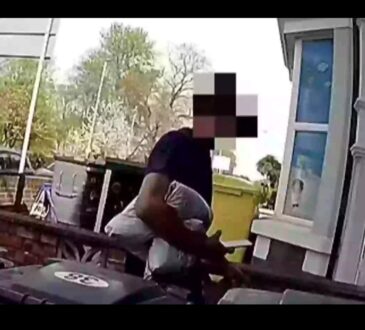
Richard Hart, a man whose tattoo sparked controversy and police intervention, remains unapologetic about his decision to adorn his body with a graphic image. The tattoo in question depicts a naked woman, her legs spread wide, spanning from Hart’s chest down to his midriff. Its provocative nature drew the attention of law enforcement, who deemed it too obscene for public display and ordered Hart to cover it up.

According to the report by The Mirror Despite facing criticism and legal pressure, Hart stands firm in his belief that his body is his canvas, and he has the right to decorate it as he sees fit. In a defiant statement to reporters, he declared, “I have no regrets about getting this tattoo. It represents who I am, and I won’t let anyone dictate what I can or cannot put on my body.”
For Hart, the tattoo is more than just a piece of art; it’s a reflection of his identity and his freedom to express himself. He sees it as a bold statement against societal norms and a rejection of conformity. To him, covering it up would be an act of capitulation, sacrificing his autonomy for the sake of appeasing others.
However, not everyone shares Hart’s perspective. Many argue that while individuals have the right to express themselves, there are limits to what is socially acceptable, especially in public spaces. Some view Hart’s tattoo as offensive and inappropriate, citing concerns about its impact on children and public decency.
The controversy surrounding Hart’s tattoo raises broader questions about the intersection of freedom of expression and community standards. Where should the line be drawn between individual rights and communal values? Who gets to decide what is considered acceptable or offensive in a diverse society?.
While Hart’s tattoo may be deemed offensive by some, others view it as a form of art and self-expression. In an era where tattoos are increasingly accepted as legitimate forms of personal expression, debates about their content and appropriateness are likely to continue.
Despite the backlash he has faced, Hart remains steadfast in his defiance. He refuses to bow to societal pressure or conform to conventional expectations. To him, the tattoo is a symbol of liberation—a reminder that he refuses to be bound by the constraints of social norms.
In the end, Hart’s tattoo serves as a reminder of the complexities of individuality and freedom. While some may find it offensive, others see it as a powerful statement of autonomy and self-expression. In a world where conformity often reigns supreme, Hart’s unwavering commitment to his tattoo is a testament to the enduring power of personal conviction.
As the debate rages on, one thing remains clear: Richard Hart has no regrets about his tattoo, and he will continue to wear it proudly, regardless of the controversy it may provoke. For him, the tattoo is more than just ink on skin—it’s a symbol of defiance, individuality, and the unyielding pursuit of freedom.




